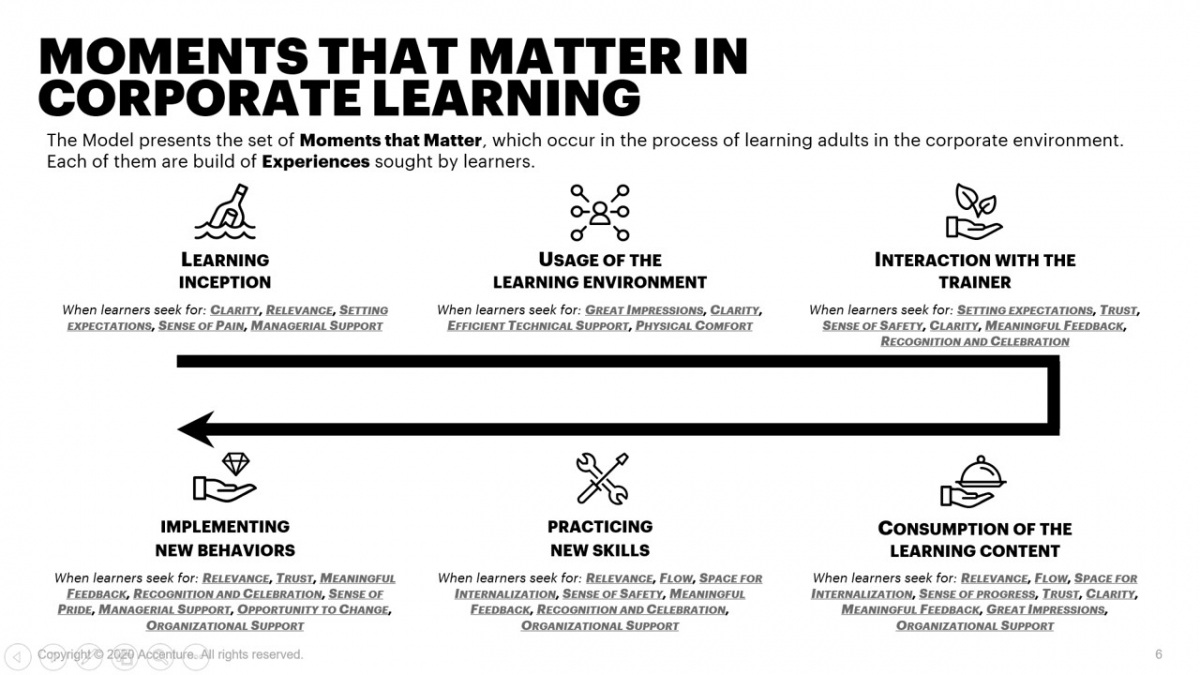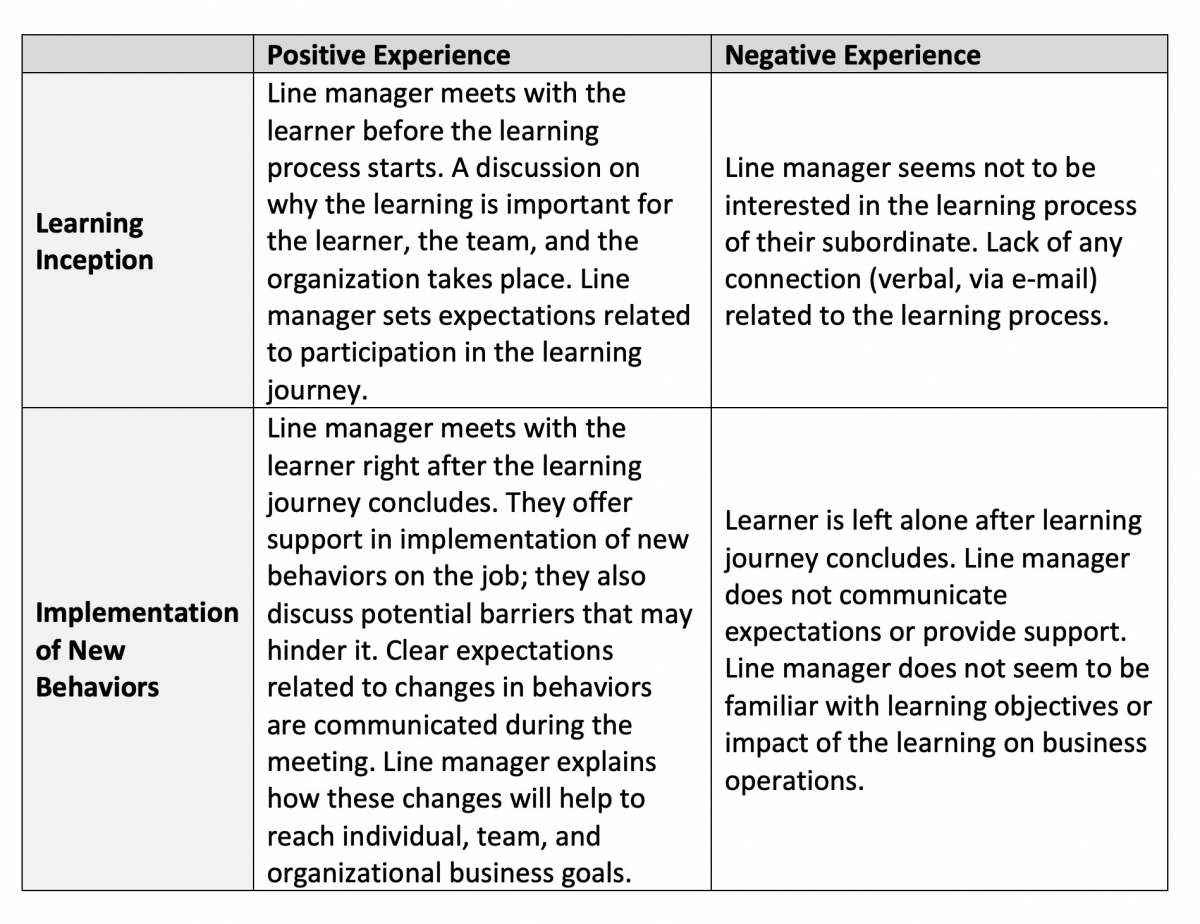Emotions and their impact on the learning process have been widely researched during the last 10 to 15 years. By investigating subjective measures (e.g., feelings), behavioral measures (e.g., facial expressions and gestures) and objective measures (e.g., physiological responses, including activities of the human nervous system), we are getting to know more and more about how learners’ emotions impact their attention, cognition, retention, reasoning, problem-solving, etc.
Keeping in mind the complexity of the subject, we turned the spotlight of our research onto one aspect of it: which experiences triggering positive or negative emotions impact engagement and motivation to enter the learning journey and move through it to the successful ending.
Moments that Matter
To investigate this topic, we employed the idea of “Moments that Matter” used in the customer service space. Sales professionals apply this concept to identify and leverage experiences that make customers repeatedly spend money on products or services. We, as Learning professionals, can learn a lot from this approach as our goal is quite similar—we should focus on making learners repeatedly spend their time and put effort into building their competencies. It simply means we must attract learners, build their satisfaction along the learning journey, and help them to appreciate the value behind the learning process itself.
The Definition
Following through the bridges between customer journey and learning journey, we can describe Moments that Matter in Corporate Learning as:
Negative or positive experiences related to the learning process that trigger deep and lasting impressions on a learner.
These experiences have the power to amplify or hinder learners’ motivations and engagement, so it is critical to create positive experiences around learning and reduce negative ones.
To help you better understand the approach we took in building the concept of Moments that Matter in Corporate Learning, I will use the analogy of a book. In the model, we don’t discuss what the book is about, but how its cover engages readers, how the size of the font helps to read it, whether the language of the book allows readers to understand it, etc. All of these characteristics either motivate or demotivate readers to take the book and immerse themselves in the narrative.
The Model
The Moments that Matter in Corporate Learning model covers six moments based on a combination of various learners’ experiences. These moments are spread across the whole learning journey, covering:
- Learning Inception, which paves the way for the learning journey of the learner.
- Usage of the Learning Environment, which empowers and supports the learner’s efforts in the journey to competence.
- Interaction with the Trainer, which leads the learner through all meanderings of the learning journey.
- Consumption of the Learning Content, which helps to build intellectual foundations for new skills.
- Practicing New Skills, which transfers learning experiences into individual capabilities.
- Implementing New Behaviors, which embeds new capabilities in the flow of the work.

NOTE: The graphic can be downloaded at the end of this article.
Experiences and Emotions
Up until now, we’ve focused on labeling motivating (if positive) or demotivating (if negative) moments in the learning journey. But it’s the experiences that play the most important part in attracting learners, keeping their attention in the short term, and retaining them in the longer run. There are 18 of these experiences and they are interwoven across all six moments. Here is a list of them with short description of the positive emotional impact:
1. Relevance: I understand why the whole process is important to me, for the team, and the company.
2. Setting Expectations: I know the expectations of my supervisor in relation to the training.
3. Sense of Pain: I am aware of my competency gap.
4. Great Impressions: Positive feelings are created around me during the learning intervention.
5. Clarity: I feel fully informed about the training program.
6. Efficient Technical Support: All my administrative and technical challenges are easily solved.
7. Physical Comfort: I feel physically comfortable in the learning space.
8. Trust: I trust the process, facilitator, mentor, etc., and I feel trusted as an adult learner.
9. Sense of Safety: I feel OK with my failures throughout the learning journey.
10. Meaningful Feedback: I am provided with meaningful feedback, which helps me to improve my performance.
11. Flow: The learning challenges are relevant to my skill level.
12. Space for Internalization: I have time for reflection after each “aha” moment.
13. Sense of Progress: I am aware how my performance improves.
14. Recognition and Celebration: I feel appreciated for my learning efforts.
15. Sense of Pride: I want to be proud of my new competency.
16. Managerial Support: I see that my supervisor cares about my training.
17. Opportunity to Change: I am provided with time/space to implement new behavior.
18. Organizational Support: I feel the organization supports and appreciates engagement in competency development.
Of course, each of these experiences also may create negative emotions when neglected or designed in an improper way.
An Example
Managerial Support shows up in two moments of the model: Learning Inception and Implementation of New Behaviors. Let’s compare both sides of the table below to find out how we can design and deliver this experience with positive and negative impact on the learner.

As you can see from the above example, each of 18 experiences has a power to either motivate or demotivate learners to participate in the learning journey. When these experiences are well designed, they also have a strong impact on building the learning culture, which may yield much stronger long-term benefits for the whole organization.
You can find more detailed description of Moments that Matter in Corporate Learning in our eBook at this link. If you would like to discuss it in even bigger detail, feel free to reach out to me by sending an e-mail to: marek.hyla@accenture.com.
Marek Hyla is a senior learning principal and Thought Leadership co-lead, Talent Development and Learning, Capability Network. He has been delivering services to the L&D industry since 1999. He has cooperated with more than 100 companies, being responsible for design of learning strategies, development of learning environments, and instructional design. As a leader of a Thought Leadership Team, he manages the network of people involved in innovative initiatives in the L&D space of Accenture. He is the author of three books (in Polish) on the topics of learning technologies and instructional design, and co-creator of Learning Battle Cards (an instructional design thinking tool) and many other concepts supporting L&D professionals.



